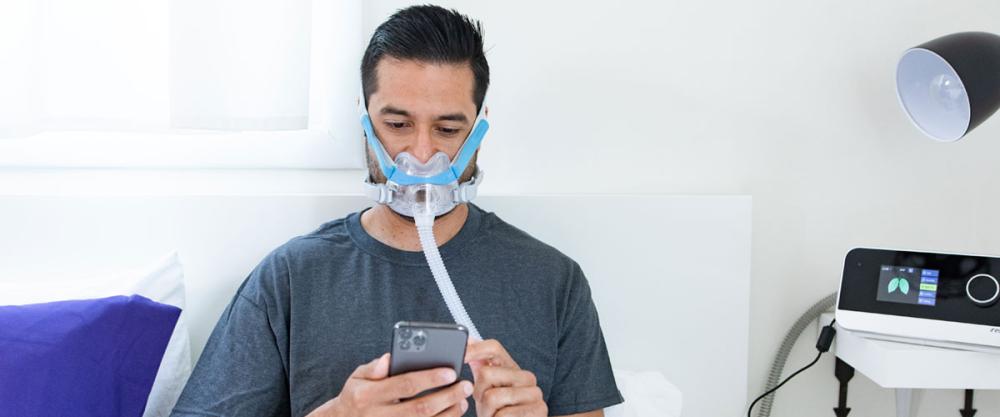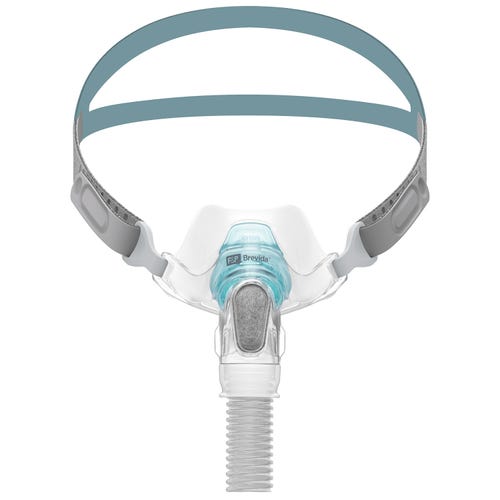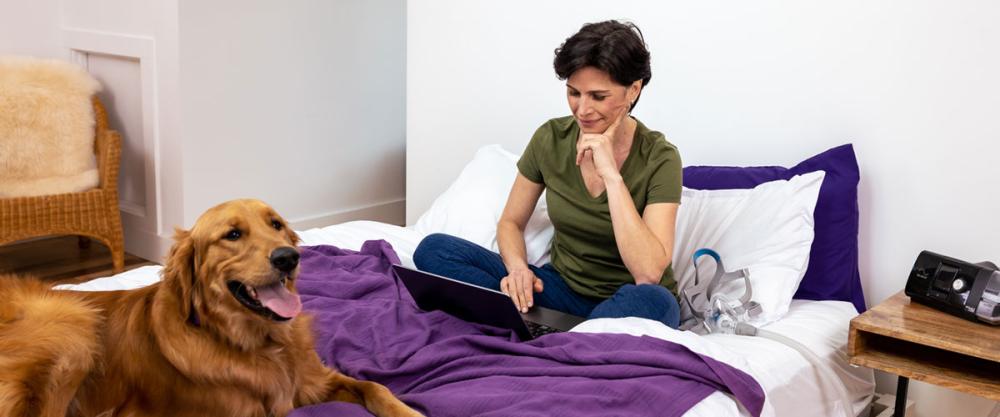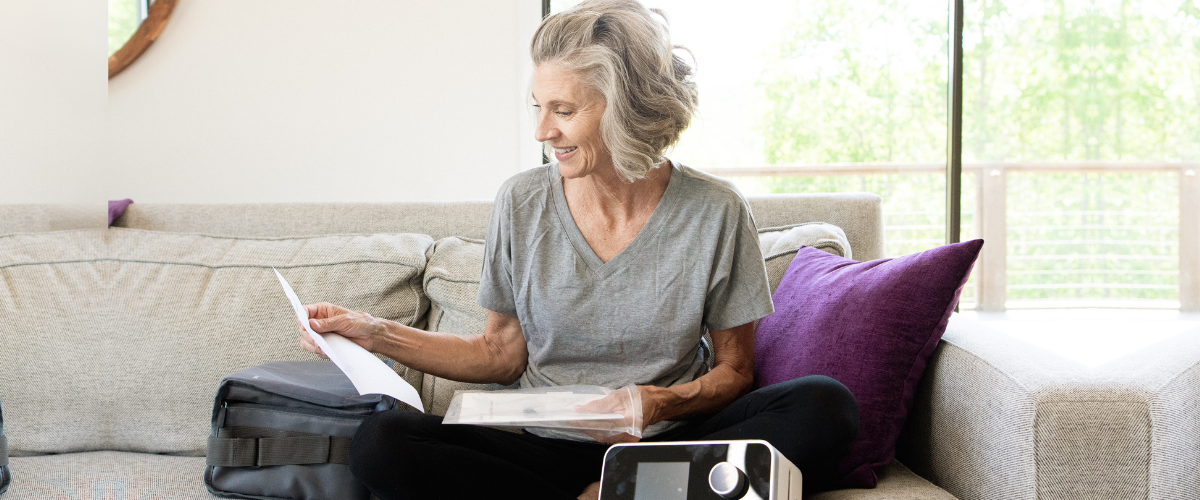When you have been diagnosed with obstructive sleep apnea (OSA), the next step in your treatment will be to get set up with a PAP device (the gold standard for sleep apnea treatment). There are different types of PAP machines, each with slightly different functionalities. Let’s dive into the types of machines available and how they treat sleep apnea.
Different Types of CPAP Machines
CPAP is often used as a blanket term that refers to all types of PAP therapy, but there are actually several different kinds of PAP machines. There is a standard CPAP machine, an APAP machine, a BiPAP machine, and a Travel CPAP machine.
Each type is designed to treat your sleep apnea with a stream of pressurized air that helps keep your upper airway from collapsing during the night. It is ultimately up to you and your healthcare provider to determine which one will be most comfortable and effective for you.
CPAP Machines
CPAP stands for continuous positive airway pressure. As the name implies, CPAP therapy delivers a single, continuous level of pressurized air during the night. While the pressure setting stays the same after reaching your prescribed level, they do come equipped with a ramp feature. This allows you time to relax and settle into bed while the pressure is still low, and then it gradually increases to your prescribed level once you are asleep.
Historically CPAP has been the most widely recommended for people with OSA, particularly when initially diagnosed. In recent years, however, many CPAP machine models have been upgraded to APAP models, see below.


APAP Machines
APAP stands for Auto-adjusting Positive Airway Pressure. It's sometimes referred to as Auto PAP or Auto CPAP machine. An APAP machine can adjust air pressure based on your needs. Instead of one prescribed pressure level, your healthcare provider will set a range of pressures and the machine will adjust within that range as needed to better accommodate your apnea.
Newer APAP machines like the ResMed Airsense 10 Autoset can identify not only OSA, but Central Sleep Apnea (CSA), Respiratory Effort Related Arousal (RERA), and Cheyne-Stokes Respiration (CSR) events as well.
BiPAP Machines
BiPAP stands for Bilevel Positive Airway Pressure and it has 2 levels of pressure. The first level of pressure is inspiratory positive airway pressure (IPAP). This higher pressure level is applied during inhalation to keep the air passage open. The second level of pressure is expiratory positive airway pressure or (EPAP). Like the APAP machine, a lower pressure level on the exhale can reduce the feeling of breathing out against the incoming air stream.
Travel CPAP Machines
Travel machines are not technically a different type of PAP machine, but they are smaller and more portable. They are available in both CPAP and APAP models, with most of the same features that their larger counterparts have. The difference is that they are much lighter and easier to travel with. Most have rechargeable batteries, ideal when you’re camping or away from a power outlet. Having one on hand is also helpful if you ever need a backup CPAP machine.
CPAP Features
When considering which types of CPAP machines to go with keep in mind that there are a few essential features to make the device more comfortable to use. Check out which options may be most beneficial for enhancing your sleep apnea treatment.
Exhalation Relief
Exhalation relief can help you get used to breathing with your mask and machine on. It was initially developed for bilevel PAP machines designed for patients with more serious respiratory conditions. Then it developed into a CPAP feature that automatically adjusts pressure settings based on your breathing patterns. The end result is a more natural, comfortable breathing experience.
Sleep Data Storage and Transfer
Most types of CPAP machines can record your therapeutic data to help you and your doctor determine the effectiveness of your treatment and to record compliance.
Recorded data can include hours of usage, average pressure, leak detection, snoring, and AHI. All of this information can be stored on a memory card or SD card that can be removed and shared with your sleep specialist. Some models have wireless or bluetooth connectivity that is linked to an app on your smartphone. This makes it easy to instantly see your sleep data and send reports to your doctor.
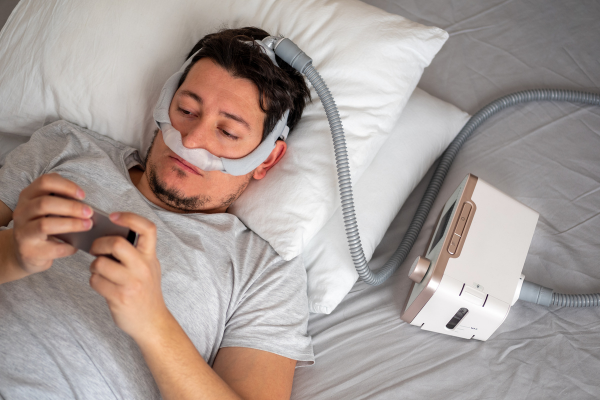

Air Leak Detection
Along with the ability to monitor breathing patterns, some CPAP machines can now detect if air is leaking from your mask, tube, or if you're breathing out of your mouth while wearing a nasal mask. The machine can then send an alert, or in some cases, adjust your airflow accordingly.
Integrated Humidifier
A CPAP with a humidifier adds moisture to your air pressure to help you breathe more comfortably. It can help reduce side effects like waking with a dry mouth and raw, irritated nose. Heated humidifiers and heated tubing heat the humidified air, which can soothe irritated airways, break up nasal congestion, and reduce allergy and cold symptoms.
Don't Forget the Mask!
Of course, further customization of your CPAP therapy is possible with different types of CPAP masks. Getting used to wearing a CPAP mask after being diagnosed with sleep apnea can take a little time. Luckily, comfortable, lightweight options have been designed to increase compliance.
Depending on your preferences and sleeping position, you may try a full face mask (especially if you breathe through mouth and nose), a nasal mask or a nasal pillow mask. All masks are cross compatible with APAP and CPAP devices.
Whether you are looking for a machine that you can travel with or if you are looking for something to use at home that has all of the technical bells and whistles, CPAPSupplies.com can help get you the right machine, mask, and accessories to fit your lifestyle and budget.
References
C;, C. M. T. S. J. M. G. (n.d.). Continuous positive airway pressure therapy in obstructive sleep apnea: Benefits and alternatives. Expert review of respiratory medicine. Retrieved March 3, 2023, from https://pubmed.ncbi.nlm.nih.gov/28287009/

